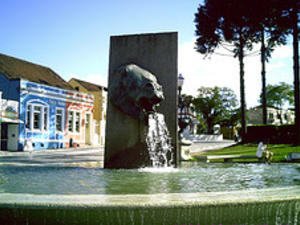 Fonte da Memoria - MAP 8 The Memory Fountain includes a large bronze horse head statue atop a fountain, which was sculpted by Ricardo Tod to honor the immigrants who would come downtown in order sell their produce and general products. Their horses would drink from the fountain placed at Largo da Ordem where a large open market still takes place every Sunday. This is part of the historical sector and thus has many other older buildings, sculpt... Fonte da Memoria - MAP 8 The Memory Fountain includes a large bronze horse head statue atop a fountain, which was sculpted by Ricardo Tod to honor the immigrants who would come downtown in order sell their produce and general products. Their horses would drink from the fountain placed at Largo da Ordem where a large open market still takes place every Sunday. This is part of the historical sector and thus has many other older buildings, sculpt... |
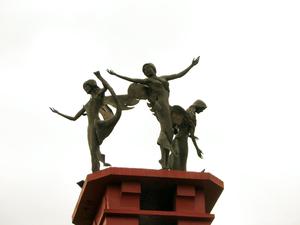 Fonte de Jerusalem - MAP 7 The fountain was inaugurated in 1995 in honor to Jerusalem's 3000 years of history. Architect Fernando Canalli designed the structure,which is 14.5 meters tall and made of concrete. On the top there are three bronze angels weighing 600 kg each. Tney were carved by plastic artist Lys Golden Buzzi, and they represent the three major monotheist religions. Christianity, Judaism and Islamism, three religions that believe in angels and regard... Fonte de Jerusalem - MAP 7 The fountain was inaugurated in 1995 in honor to Jerusalem's 3000 years of history. Architect Fernando Canalli designed the structure,which is 14.5 meters tall and made of concrete. On the top there are three bronze angels weighing 600 kg each. Tney were carved by plastic artist Lys Golden Buzzi, and they represent the three major monotheist religions. Christianity, Judaism and Islamism, three religions that believe in angels and regard... |
| Fonte Maria Lata D’Agua - MAP 7 Located in the Historic Sector, this fountain was inaugurated in 1996. The structure is built from concrete and occupies an area of approximately 36 square meters, with a roughly half meter deep pool. Within the fountain is a reproduction of the sculpture "Água pro Morro" dating back to the early forties and whose artist was Erbo Stenzel, one of the most important plastic artists of Paraná.
Since the... |
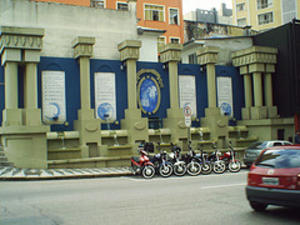 Fonte Mocinhas da Cidade - MAP 7 This fountain designed by Fernando Canalli pays homage to local singing duo Nhô Belarmino e Nhá Gabriela. Columns frame the tiled pictures, which have the verses to the song "Young girls of the City", which was first recorded in the early 50's.
There are many parks, memorials, museums and fountains within Curitiba. The city is known for its abundant green areas and public areas. This fountain... Fonte Mocinhas da Cidade - MAP 7 This fountain designed by Fernando Canalli pays homage to local singing duo Nhô Belarmino e Nhá Gabriela. Columns frame the tiled pictures, which have the verses to the song "Young girls of the City", which was first recorded in the early 50's.
There are many parks, memorials, museums and fountains within Curitiba. The city is known for its abundant green areas and public areas. This fountain... |
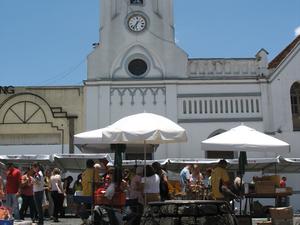 Historical Sector - MAP 7 The oldest buildings in the city are found around the historical sector and the area is protected by a municipal decree in 1971 declaring all of the buildings historic. Among these buildings includes the house of Romário Martins, from the 1800's and the Church of the Third Order of São Francisco dating back to 1737. There are also many examples of German inspiration from the 1900's due to the large German population ... Historical Sector - MAP 7 The oldest buildings in the city are found around the historical sector and the area is protected by a municipal decree in 1971 declaring all of the buildings historic. Among these buildings includes the house of Romário Martins, from the 1800's and the Church of the Third Order of São Francisco dating back to 1737. There are also many examples of German inspiration from the 1900's due to the large German population ... |
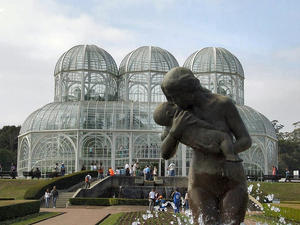 Jardim Botanico - MAP 8 This botanical garden was first inaugurated in 1991 and is one of the most visited places in Curitiba. The Jardim Botanico is a must see vacation destination in Curitiba. Designed after the French Gardens, it unfolds a carpet of flowers which starts right at the entrance and goes throughout the entire garden. The green house is built with a metallic structure which contains many botanical species and a natural spring water s... Jardim Botanico - MAP 8 This botanical garden was first inaugurated in 1991 and is one of the most visited places in Curitiba. The Jardim Botanico is a must see vacation destination in Curitiba. Designed after the French Gardens, it unfolds a carpet of flowers which starts right at the entrance and goes throughout the entire garden. The green house is built with a metallic structure which contains many botanical species and a natural spring water s... |
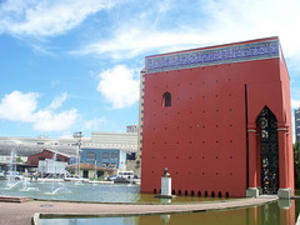 Memorial Arabe - MAP 7 At Claudino dos Santos Street – São Francisco. Opens from Monday to Friday, from 9AM to 6PM, and on Saturdays, 9AM to 1PM. Celebrating the Middle-Eastern culture, it works as a specialized library. The building reminds of the architectural style of the Moorish buildings, with elements such as the vault, the columns, the arches and the stained glass windows. With just over 140 square meters of built area, the Memorial has a ... Memorial Arabe - MAP 7 At Claudino dos Santos Street – São Francisco. Opens from Monday to Friday, from 9AM to 6PM, and on Saturdays, 9AM to 1PM. Celebrating the Middle-Eastern culture, it works as a specialized library. The building reminds of the architectural style of the Moorish buildings, with elements such as the vault, the columns, the arches and the stained glass windows. With just over 140 square meters of built area, the Memorial has a ... |
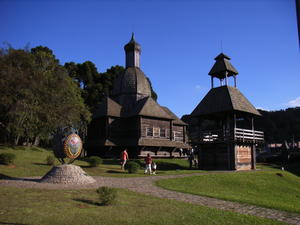 Memorial Ucraniano - MAP 8 Located in Tingüi Parque, the Ukrainian Memorial pays tribute to Ukrainian immigrants in Curitiba. Opened in 1995, which commemorated the centenary of the arrival of these immigrants to Curitiba.
The memorial is based around a replica of the church of St. Michael the Archangel, a traditional Ukrainian style house, an outdoor stage where performances take place, a souvenir shop which is in a traditional Ukrainian house and the ... Memorial Ucraniano - MAP 8 Located in Tingüi Parque, the Ukrainian Memorial pays tribute to Ukrainian immigrants in Curitiba. Opened in 1995, which commemorated the centenary of the arrival of these immigrants to Curitiba.
The memorial is based around a replica of the church of St. Michael the Archangel, a traditional Ukrainian style house, an outdoor stage where performances take place, a souvenir shop which is in a traditional Ukrainian house and the ... |
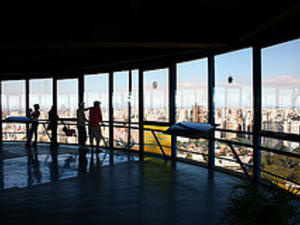 Mercês Tower - MAP 7 The Mercês Tower is the highest point in Curitiba, allowing a 360 degree vision of the city, and allows visitors to view the city from a height of 95 meters. It is managed by Telepar and Curitiba City Hall, which also promote video sessions and guided tourist programs. Also located here is the Telephone Museum which makes for two nearby tourist destinations in one!
The tower is located near ... Mercês Tower - MAP 7 The Mercês Tower is the highest point in Curitiba, allowing a 360 degree vision of the city, and allows visitors to view the city from a height of 95 meters. It is managed by Telepar and Curitiba City Hall, which also promote video sessions and guided tourist programs. Also located here is the Telephone Museum which makes for two nearby tourist destinations in one!
The tower is located near ... |
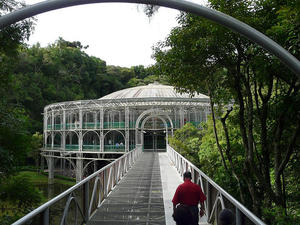 Opera de Arame - MAP 8 Also known as the Wire Theater and in the Parque das Pedreiras, and within the Paulo Leminski cultural space.
The Opera de Arame with its tubular structure and transparent roof is one of Curitiba's emblematic symbols. Inaugurated in 1992, it gives place to all kinds of events, from pop to classical music concerts. Surrounded by lakes, native vegetation and cascades in a natural landscape, it belongs to the Parque das Pedrei... Opera de Arame - MAP 8 Also known as the Wire Theater and in the Parque das Pedreiras, and within the Paulo Leminski cultural space.
The Opera de Arame with its tubular structure and transparent roof is one of Curitiba's emblematic symbols. Inaugurated in 1992, it gives place to all kinds of events, from pop to classical music concerts. Surrounded by lakes, native vegetation and cascades in a natural landscape, it belongs to the Parque das Pedrei... |
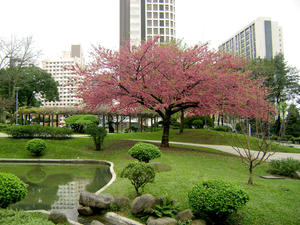 Praça do Japão - MAP 7 The square honors the sons of the "Rising Sun", who settled there and dedicated themselves to an agriculture life. Scattered around the square there are 30 cherry trees sent from Japan by the Nipponese empire and several artificial Japanese style lakes. Japanese Portal, the Culture House and the Tea House were built in 1993.
Curitiba was the home to many immigrants and thus it has have a very diverse cultural backgrou... Praça do Japão - MAP 7 The square honors the sons of the "Rising Sun", who settled there and dedicated themselves to an agriculture life. Scattered around the square there are 30 cherry trees sent from Japan by the Nipponese empire and several artificial Japanese style lakes. Japanese Portal, the Culture House and the Tea House were built in 1993.
Curitiba was the home to many immigrants and thus it has have a very diverse cultural backgrou... |
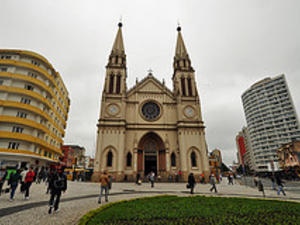 Praça Tiradentes - MAP 7 This is often considered the very center of Curitiba, and part of the current Historic Sector, where the city began. The site now has several historic statues of figures that contributed to the growth of the city and has plenty of land marks around the square. Along with statues of historic figures, there is a prominent Cross of Christ, which symbolises power that was legally appointed by the King of Portugal, on March 29, 1693.... Praça Tiradentes - MAP 7 This is often considered the very center of Curitiba, and part of the current Historic Sector, where the city began. The site now has several historic statues of figures that contributed to the growth of the city and has plenty of land marks around the square. Along with statues of historic figures, there is a prominent Cross of Christ, which symbolises power that was legally appointed by the King of Portugal, on March 29, 1693.... |
| Ruinas de São Francisco - MAP 7 The ruins are a result of the São Francisco de Paula Church never being completed due to the fact that the finishing materials were diverted to another church. In 1811, the chapel and the sacristy were finished, however, by 1860 the stones that would finish up the building were used to finish the main tower of the ancient church, which is nowadays the Minor Basilica Cathedral of Our Lady of Light.
T... |
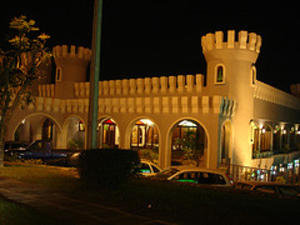 Santa Felicidade - MAP 7 Santa Felicidade is a neighborhood where some of the very first Italian immigrants arrived in Paraná. Much of the culture has been preserved here by the Italian immigrants that arrived in the 1800's. Originally the Italians were dedicated to the production of cheese, wine and farming or horticulture.
The Saint Josephe Church was built in 1891, followed be the first school and it still posses some of the original buildin... Santa Felicidade - MAP 7 Santa Felicidade is a neighborhood where some of the very first Italian immigrants arrived in Paraná. Much of the culture has been preserved here by the Italian immigrants that arrived in the 1800's. Originally the Italians were dedicated to the production of cheese, wine and farming or horticulture.
The Saint Josephe Church was built in 1891, followed be the first school and it still posses some of the original buildin... |
 Fonte da Memoria - MAP 8 The Memory Fountain includes a large bronze horse head statue atop a fountain, which was sculpted by Ricardo Tod to honor the immigrants who would come downtown in order sell their produce and general products. Their horses would drink from the fountain placed at Largo da Ordem where a large open market still takes place every Sunday. This is part of the historical sector and thus has many other older buildings, sculpt...
Fonte da Memoria - MAP 8 The Memory Fountain includes a large bronze horse head statue atop a fountain, which was sculpted by Ricardo Tod to honor the immigrants who would come downtown in order sell their produce and general products. Their horses would drink from the fountain placed at Largo da Ordem where a large open market still takes place every Sunday. This is part of the historical sector and thus has many other older buildings, sculpt... Fonte de Jerusalem - MAP 7 The fountain was inaugurated in 1995 in honor to Jerusalem's 3000 years of history. Architect Fernando Canalli designed the structure,which is 14.5 meters tall and made of concrete. On the top there are three bronze angels weighing 600 kg each. Tney were carved by plastic artist Lys Golden Buzzi, and they represent the three major monotheist religions. Christianity, Judaism and Islamism, three religions that believe in angels and regard...
Fonte de Jerusalem - MAP 7 The fountain was inaugurated in 1995 in honor to Jerusalem's 3000 years of history. Architect Fernando Canalli designed the structure,which is 14.5 meters tall and made of concrete. On the top there are three bronze angels weighing 600 kg each. Tney were carved by plastic artist Lys Golden Buzzi, and they represent the three major monotheist religions. Christianity, Judaism and Islamism, three religions that believe in angels and regard... Fonte Mocinhas da Cidade - MAP 7 This fountain designed by Fernando Canalli pays homage to local singing duo Nhô Belarmino e Nhá Gabriela. Columns frame the tiled pictures, which have the verses to the song "Young girls of the City", which was first recorded in the early 50's.
There are many parks, memorials, museums and fountains within Curitiba. The city is known for its abundant green areas and public areas. This fountain...
Fonte Mocinhas da Cidade - MAP 7 This fountain designed by Fernando Canalli pays homage to local singing duo Nhô Belarmino e Nhá Gabriela. Columns frame the tiled pictures, which have the verses to the song "Young girls of the City", which was first recorded in the early 50's.
There are many parks, memorials, museums and fountains within Curitiba. The city is known for its abundant green areas and public areas. This fountain... Historical Sector - MAP 7 The oldest buildings in the city are found around the historical sector and the area is protected by a municipal decree in 1971 declaring all of the buildings historic. Among these buildings includes the house of Romário Martins, from the 1800's and the Church of the Third Order of São Francisco dating back to 1737. There are also many examples of German inspiration from the 1900's due to the large German population ...
Historical Sector - MAP 7 The oldest buildings in the city are found around the historical sector and the area is protected by a municipal decree in 1971 declaring all of the buildings historic. Among these buildings includes the house of Romário Martins, from the 1800's and the Church of the Third Order of São Francisco dating back to 1737. There are also many examples of German inspiration from the 1900's due to the large German population ... Jardim Botanico - MAP 8 This botanical garden was first inaugurated in 1991 and is one of the most visited places in Curitiba. The Jardim Botanico is a must see vacation destination in Curitiba. Designed after the French Gardens, it unfolds a carpet of flowers which starts right at the entrance and goes throughout the entire garden. The green house is built with a metallic structure which contains many botanical species and a natural spring water s...
Jardim Botanico - MAP 8 This botanical garden was first inaugurated in 1991 and is one of the most visited places in Curitiba. The Jardim Botanico is a must see vacation destination in Curitiba. Designed after the French Gardens, it unfolds a carpet of flowers which starts right at the entrance and goes throughout the entire garden. The green house is built with a metallic structure which contains many botanical species and a natural spring water s... Memorial Arabe - MAP 7 At Claudino dos Santos Street – São Francisco. Opens from Monday to Friday, from 9AM to 6PM, and on Saturdays, 9AM to 1PM. Celebrating the Middle-Eastern culture, it works as a specialized library. The building reminds of the architectural style of the Moorish buildings, with elements such as the vault, the columns, the arches and the stained glass windows. With just over 140 square meters of built area, the Memorial has a ...
Memorial Arabe - MAP 7 At Claudino dos Santos Street – São Francisco. Opens from Monday to Friday, from 9AM to 6PM, and on Saturdays, 9AM to 1PM. Celebrating the Middle-Eastern culture, it works as a specialized library. The building reminds of the architectural style of the Moorish buildings, with elements such as the vault, the columns, the arches and the stained glass windows. With just over 140 square meters of built area, the Memorial has a ... Memorial Ucraniano - MAP 8 Located in Tingüi Parque, the Ukrainian Memorial pays tribute to Ukrainian immigrants in Curitiba. Opened in 1995, which commemorated the centenary of the arrival of these immigrants to Curitiba.
The memorial is based around a replica of the church of St. Michael the Archangel, a traditional Ukrainian style house, an outdoor stage where performances take place, a souvenir shop which is in a traditional Ukrainian house and the ...
Memorial Ucraniano - MAP 8 Located in Tingüi Parque, the Ukrainian Memorial pays tribute to Ukrainian immigrants in Curitiba. Opened in 1995, which commemorated the centenary of the arrival of these immigrants to Curitiba.
The memorial is based around a replica of the church of St. Michael the Archangel, a traditional Ukrainian style house, an outdoor stage where performances take place, a souvenir shop which is in a traditional Ukrainian house and the ... Mercês Tower - MAP 7 The Mercês Tower is the highest point in Curitiba, allowing a 360 degree vision of the city, and allows visitors to view the city from a height of 95 meters. It is managed by Telepar and Curitiba City Hall, which also promote video sessions and guided tourist programs. Also located here is the Telephone Museum which makes for two nearby tourist destinations in one!
The tower is located near ...
Mercês Tower - MAP 7 The Mercês Tower is the highest point in Curitiba, allowing a 360 degree vision of the city, and allows visitors to view the city from a height of 95 meters. It is managed by Telepar and Curitiba City Hall, which also promote video sessions and guided tourist programs. Also located here is the Telephone Museum which makes for two nearby tourist destinations in one!
The tower is located near ... Opera de Arame - MAP 8 Also known as the Wire Theater and in the Parque das Pedreiras, and within the Paulo Leminski cultural space.
The Opera de Arame with its tubular structure and transparent roof is one of Curitiba's emblematic symbols. Inaugurated in 1992, it gives place to all kinds of events, from pop to classical music concerts. Surrounded by lakes, native vegetation and cascades in a natural landscape, it belongs to the Parque das Pedrei...
Opera de Arame - MAP 8 Also known as the Wire Theater and in the Parque das Pedreiras, and within the Paulo Leminski cultural space.
The Opera de Arame with its tubular structure and transparent roof is one of Curitiba's emblematic symbols. Inaugurated in 1992, it gives place to all kinds of events, from pop to classical music concerts. Surrounded by lakes, native vegetation and cascades in a natural landscape, it belongs to the Parque das Pedrei... Praça do Japão - MAP 7 The square honors the sons of the "Rising Sun", who settled there and dedicated themselves to an agriculture life. Scattered around the square there are 30 cherry trees sent from Japan by the Nipponese empire and several artificial Japanese style lakes. Japanese Portal, the Culture House and the Tea House were built in 1993.
Curitiba was the home to many immigrants and thus it has have a very diverse cultural backgrou...
Praça do Japão - MAP 7 The square honors the sons of the "Rising Sun", who settled there and dedicated themselves to an agriculture life. Scattered around the square there are 30 cherry trees sent from Japan by the Nipponese empire and several artificial Japanese style lakes. Japanese Portal, the Culture House and the Tea House were built in 1993.
Curitiba was the home to many immigrants and thus it has have a very diverse cultural backgrou... Praça Tiradentes - MAP 7 This is often considered the very center of Curitiba, and part of the current Historic Sector, where the city began. The site now has several historic statues of figures that contributed to the growth of the city and has plenty of land marks around the square. Along with statues of historic figures, there is a prominent Cross of Christ, which symbolises power that was legally appointed by the King of Portugal, on March 29, 1693....
Praça Tiradentes - MAP 7 This is often considered the very center of Curitiba, and part of the current Historic Sector, where the city began. The site now has several historic statues of figures that contributed to the growth of the city and has plenty of land marks around the square. Along with statues of historic figures, there is a prominent Cross of Christ, which symbolises power that was legally appointed by the King of Portugal, on March 29, 1693.... Santa Felicidade - MAP 7 Santa Felicidade is a neighborhood where some of the very first Italian immigrants arrived in Paraná. Much of the culture has been preserved here by the Italian immigrants that arrived in the 1800's. Originally the Italians were dedicated to the production of cheese, wine and farming or horticulture.
The Saint Josephe Church was built in 1891, followed be the first school and it still posses some of the original buildin...
Santa Felicidade - MAP 7 Santa Felicidade is a neighborhood where some of the very first Italian immigrants arrived in Paraná. Much of the culture has been preserved here by the Italian immigrants that arrived in the 1800's. Originally the Italians were dedicated to the production of cheese, wine and farming or horticulture.
The Saint Josephe Church was built in 1891, followed be the first school and it still posses some of the original buildin...